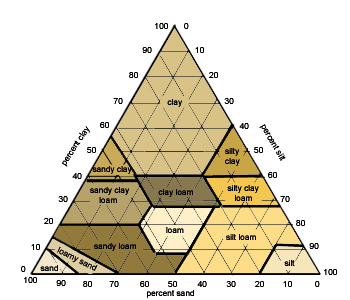Lady's Heart of the Home |

Shake Up Your Soilby Carrie P. WilliamsTurf Tamer, Inc. Many of us know that our soil isn't as good as we want it to be. Some soils are extremely sandy and do not hold water at all. Other soils are mostly clay and hold water all too well. However, it can be maddeningly difficult to decipher what exactly your soil is composed of that keeps it from being your plant's dirt paradise. However, determining what type of soil that you have is not only easy, it can be very amusing. After all, for this experiment you get another chance to dig in the dirt. The soil in your yard is made up of three main components: sand, silt, and clay. The ideal ratio of these three components in your soil is 1:1:1, or about 33% of each; this is called a loamy soil. It provides good drainage while still has a good water-holding capacity. Knowing what percentage of each component you have in your soil gives you the information you need to amend your soil properly. To determine the amount of sand, silt, and clay in your soil, there is a simple test that you can do by just using materials around your home. First, you will need a glass jar with straight sides. A mason jar works really well, and make sure you have the top to the jar. Second, you will need some clean water. The third item on the list is a surfactant like liquid dishwashing detergent. Lastly, you need some soil from your yard. Try to remove all large rocks, pebbles, and plant material from the soil. Fill up the jar with water until it is about 1/2 to 3/4 full, then add one teaspoon of the detergent. Now, sprinkle in the soil from your yard until the jar is almost full; you need to leave a little space of air so the concoction will mix well. Screw on the top and check to make sure it is tightly sealed. Now for the fun part. Shake the jar vigorously to mix together the soil, water, and detergent. A good one to two minutes should do it; your goal is to break up all the soil chunks and mix them in with the soapy water. Once you think it's well-mixed, set the jar down on a flat surface. Sand is the heaviest particle in your soil, and it will settle first. Most of the sand should sink to the bottom within the first minute after you've stopped shaking the jar. Once you think the sand is all settled, mark the jar with a permanent marker where the top of the sand layer is. The silt is the next heaviest particle, and should settle during the next four hours. When it has settled, once again mark the top of the silt layer with a waterproof pen. The clay particles are the lightest, and should settle after 24 hours. Mark the top of the clay layer on the jar when it has settled. Once your soil layers are settled and marked, you can analyze the thickness of the levels to see how much of each component you have. Observe the layers and give each a percentage based on it's size compared to the entire soil sample. This number does not have to be exact, just make sure that the three percentages add up to be 100%. For example, your soil sample might look like it is 40% sand, 40% silt, and 20% clay. This adds up to 100% soil. You can use these three numbers to determine the texture of your soil using a table called the Soil Texture Triangle (see below). The Soil Texture Triangle To use the Soil Texture Triangle, find the percentage number of your three components on the table. To follow along with our previous example of 40-40-20, first look at the 'percent sand' section at the bottom of the triangle. 40% is a little to the right of center. The 'percent silt' section is the right side of the triangle, where 40% is just a little above center. Lastly, the 'percent clay' section is on the left side of the triangle, and 20% is near the bottom. Follow along with your eyes or use your fingers to trace the three lines coming from the percentage numbers until they all intersect at a point. For our example, all three lines intersect in the middle bottom of the triangle in the colored section called 'loam.' This means that your soil has a loamy texture, and will work quite well for growing plants and turf. Study the Soil Texture Triangle to see what different combinations create different soil textures. There are twelve main textures that your soil can have. It can range from clay to sandy clay loam to silt, with a whole lot more choices in between. By determining what type of soil texture you have, you can then make any necessary adjustments to create a good, loamy soil to support your plants. Carrie P. Williams is a professional landscape designer with Turf Tamer, Inc. She has written many informative landscaping articles for Turf Tamer's Tip of the Week program. Want to learn more landscaping tips and tricks? Go to Turf Tamer, Inc. to sign up for the 'Tip of the Week' and learn more tips! Please post your comments about this article on the
No right click ResourcesLinks are provided for your information and enjoyment. The links do not imply endorsement of the sites' products or advice. |